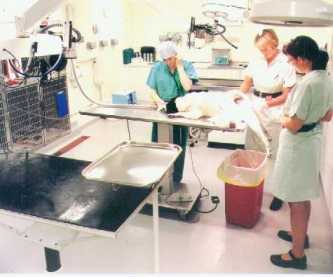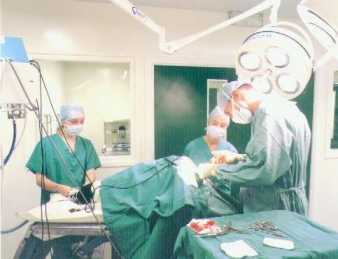A
new condition in the Border Collie?
 As
a veterinary orthopaedic surgeon, Mike Guilluard finds that the Border Collie is one of the few
breeds not plagued by inherited lameness problems. Hip dysplasia occurs in the breed but
infrequently causes a clinical problem; and elbow dysplasia, so common in retrievers and
shepherds, is non-existent. Likewise cruciate disease in the stifle joint, our commonest
orthopaedic condition, is very rare. However, in March Sue Duncan's dog Teddy needed an
operation for this 'new' condition in the breed - Tarsal Lameness. As
a veterinary orthopaedic surgeon, Mike Guilluard finds that the Border Collie is one of the few
breeds not plagued by inherited lameness problems. Hip dysplasia occurs in the breed but
infrequently causes a clinical problem; and elbow dysplasia, so common in retrievers and
shepherds, is non-existent. Likewise cruciate disease in the stifle joint, our commonest
orthopaedic condition, is very rare. However, in March Sue Duncan's dog Teddy needed an
operation for this 'new' condition in the breed - Tarsal Lameness.
 Lameness
problems in Border Collies are usually the result of an accident or degenerative joint disease
also called 'wear and tear.' This problem becomes most apparent in the older dog after a
lifetime of ball chasing and retrieving resulting in stiffness with a decreased range of motion
in the small joints between the toes and the metacarpal bones. However degenerative changes to
the tarsus are a very common coincidental finding that has been recognised for a number of
years but, until now, have not been associated with lameness. Lameness
problems in Border Collies are usually the result of an accident or degenerative joint disease
also called 'wear and tear.' This problem becomes most apparent in the older dog after a
lifetime of ball chasing and retrieving resulting in stiffness with a decreased range of motion
in the small joints between the toes and the metacarpal bones. However degenerative changes to
the tarsus are a very common coincidental finding that has been recognised for a number of
years but, until now, have not been associated with lameness.
The tarsus is that small area of the
hind leg between the hock (ankle) joint and the metatarsal bones. It consists of three rows of
bones separated by low motion joints and supported by a very strong plantar ligament running
down the back surface. Typical degenerative changes seen on X-rays are new bone at the
attachments of the plantar ligament and a bony bridging of the lower tarsal joint technically
called the centrodistal joint as it is between the central tarsal bone and the second and third
tarsal bones on the front of the inside tarsus.
 Centrodistal
joint lameness has been identified by myself over the last three years as a common cause of
chronic hind limb lameness in the Border Collie and the question arises as to why this
condition has not been recognised until now. The reason is that diagnosis is bases solely on a
specific manipulative manoeuvre that applies rotational stress to the inside of the tarsus.
Diagnosis is supported by degenerative signs on X-ray but these are not always present. Other
causes of hind limb lameness also have to be eliminated. Centrodistal
joint lameness has been identified by myself over the last three years as a common cause of
chronic hind limb lameness in the Border Collie and the question arises as to why this
condition has not been recognised until now. The reason is that diagnosis is bases solely on a
specific manipulative manoeuvre that applies rotational stress to the inside of the tarsus.
Diagnosis is supported by degenerative signs on X-ray but these are not always present. Other
causes of hind limb lameness also have to be eliminated.
Symptoms
The clinical signs are usually of a sudden onset chronic lameness that is often poorly
responsive to rest and non-steroidal anti-inflammatory pain killers. Typically in the more
severe cases the dog will stand toe-touching but will use the limb to walk and trot with little
lameness. Stressing the inside of the tarsus produces a pain response and an exacerbation of
the lameness.
 Treatment Treatment
Successful treatment is by fusing the centrodistal joint by the insertion of a high speed burr
into the joint spaces and this leads to the characteristic bony bridging. Amazingly all the
dogs have improved at the time of suture removal and are completely sound after six weeks with
no recurrence. Undoubtedly some dogs will cure themselves by the natural fusion of the joint
but this can take a considerable time, and bilateral cases can occur with exercise intolerance.
The other commonly affected breed is
the racing Greyhound in which a tarsal sprain injury is recognised. The clue to the successful
treatment came from an original case in a Border Collie that had had severe lameness for four
months prior to my examination. This dog had degenerative changes to the attachments of the
plantar ligament but had bony bridging in the sound tarsus. With trepidation the lame tarsus
was burred, bony bridging occurred and the rest is history.
 About
the author... About
the author...
Mike Guilliard MA VetMB CertSAO MRCVS qualified from Cambridge University Veterinary
School in 1972 and, having been with the practice for 27 years, is now the Senior Partner. He
obtained the Certificate of Small Animal Orthopaedics in 1995 and has since had published
several scientific papers on sports injuries in peer-reviewed veterinary journals. He was
awarded the Dunkin Prize in 1998 by the British Small Animal Veterinary Association, given to
the author of the best paper published in the Journal of Small Animal Practice written by a
general practitioner.
He is an active member of the Society of Greyhound
Veterinarians and is involved in the veterinary care of a number of top greyhound kennels.
For more information, contact Mike
Guilliard MA VetMB CertSAO MRCVS,
Nantwich Veterinary Hospital, Crewe Road, Nantwich CW5 5SF
or visit
http://www.nantwichvet.co.uk
|